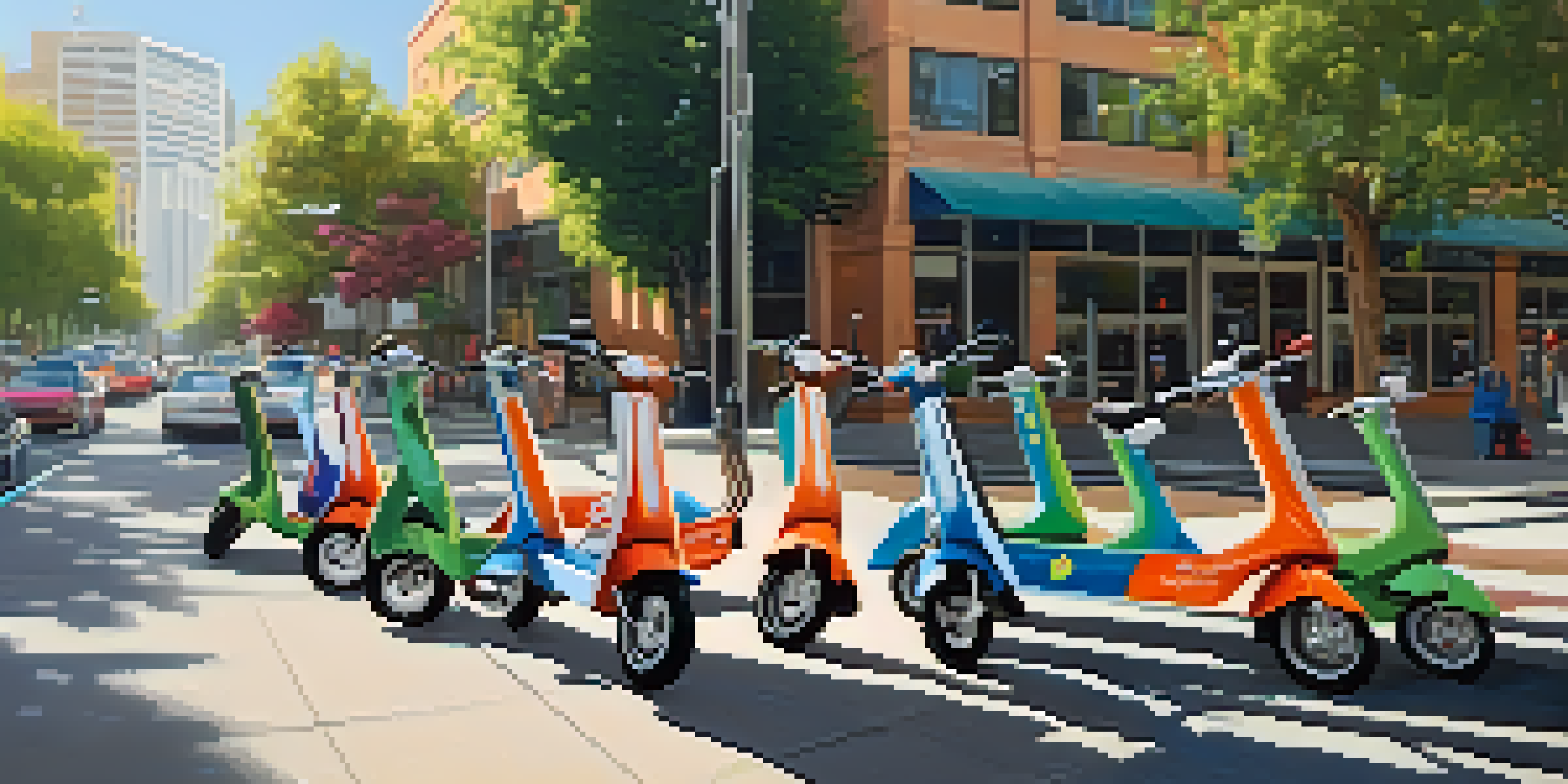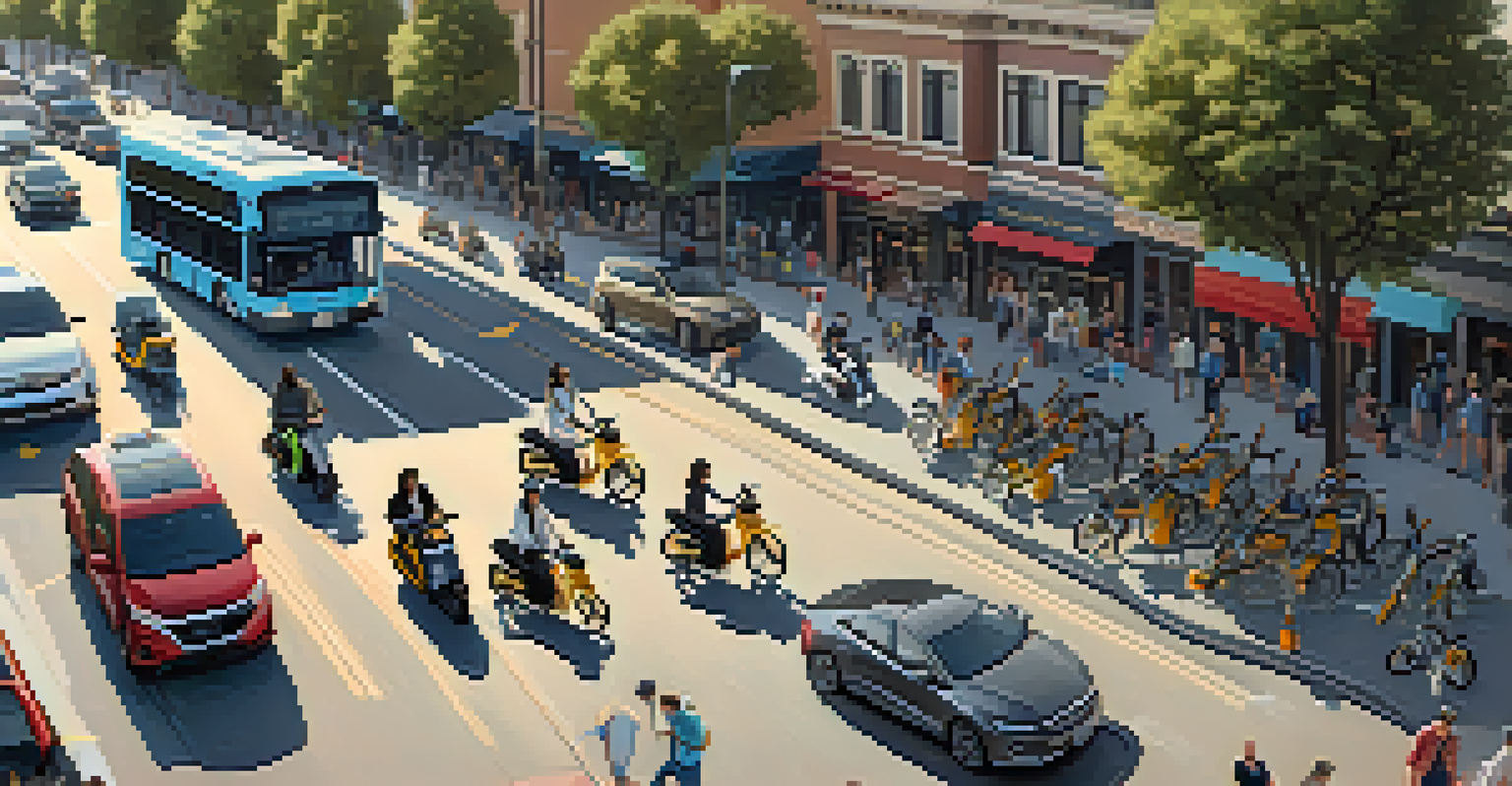The Rise of E-Scooters: Transforming Urban Mobility in Sacramento

Understanding E-Scooters and Their Popularity
E-scooters have become a common sight in cities worldwide, and Sacramento is no exception. With their sleek designs and ease of use, these electric vehicles offer a fun and efficient way to navigate urban landscapes. As more people seek alternatives to traditional transportation, e-scooters have positioned themselves as a popular choice for short trips and casual rides.
E-scooters are not just a new mode of transport; they represent a shift in how we navigate urban spaces sustainably.
The surge in their popularity can be attributed to several factors, including convenience, affordability, and eco-friendliness. Many users appreciate the ability to quickly hop on a scooter and glide to their destination without the hassle of parking or traffic. Additionally, e-scooters provide a greener option for commuters looking to reduce their carbon footprint.
In Sacramento, the integration of e-scooters into the urban mobility landscape has sparked interest among both residents and visitors. With easy-to-use apps and a variety of models available, it's no wonder that e-scooters are becoming a preferred mode of transport for many.
The Benefits of E-Scooters for Urban Commuters
E-scooters offer numerous advantages for urban commuters, particularly in terms of time and cost savings. For instance, a typical e-scooter ride can be significantly quicker than navigating through congested traffic, making it an appealing option for those with tight schedules. Also, the cost of e-scooter rentals is often less than traditional taxi or rideshare services.

Moreover, e-scooters promote a more active lifestyle by encouraging users to incorporate movement into their daily routines. Rather than being stuck in a car or bus, riders can enjoy the fresh air and engage with their surroundings. This shift not only benefits individual health but also contributes to a more vibrant city atmosphere.
E-Scooters Enhance Urban Mobility
E-scooters provide a convenient and eco-friendly alternative to traditional transportation, making them increasingly popular for short trips.
Additionally, e-scooters help reduce the number of cars on the road, which can lead to decreased traffic congestion and improved air quality. As cities like Sacramento seek to become more sustainable, e-scooters provide a viable solution to urban mobility challenges.
E-Scooter Infrastructure in Sacramento
For e-scooters to thrive, a supportive infrastructure is essential. Sacramento has taken strides to create bike lanes and designated parking areas that accommodate e-scooter users. This infrastructure not only ensures safety for riders but also encourages more people to consider e-scooters as a commuting option.
The future of urban mobility lies in embracing technologies that promote convenience, safety, and environmental consciousness.
The city has also implemented policies aimed at regulating e-scooter usage, such as speed limits and parking guidelines. These measures help prevent accidents and maintain order on the streets, making e-scooters a responsible choice for urban travel. By establishing clear rules, Sacramento is fostering a safe environment for both riders and pedestrians.
As e-scooter usage continues to grow, ongoing investments in infrastructure will be crucial. Enhancing connectivity between existing bike paths and public transport hubs can pave the way for a more integrated urban mobility system that benefits everyone.
Challenges Facing E-Scooter Adoption in Sacramento
Despite their many benefits, e-scooters also face challenges that can hinder widespread adoption. One notable issue is the inconsistency in user behavior, with some riders neglecting to follow traffic rules or park responsibly. This can lead to frustration among pedestrians and other road users, highlighting the need for better education and awareness.
Another challenge is the maintenance and management of e-scooter fleets. Ensuring that scooters are charged, functional, and available in high-demand areas requires coordination between companies and local authorities. This ongoing effort can strain resources, especially as the popularity of e-scooters continues to rise.
Infrastructure Supports E-Scooters
Sacramento's investment in bike lanes and parking areas fosters a safer environment for e-scooter users and encourages broader adoption.
Finally, concerns about safety cannot be overlooked. Accidents and injuries involving e-scooters have been reported, prompting calls for improved safety measures. Addressing these concerns will be essential for building public trust and encouraging more people to embrace e-scooter travel.
The Role of Technology in E-Scooter Usage
Technology plays a pivotal role in the e-scooter experience, from smartphone apps to GPS tracking. Users can easily locate available scooters and unlock them with a few taps on their phones. This seamless integration of technology makes e-scooters not only convenient but also appealing to a tech-savvy generation.
Additionally, many e-scooter companies are leveraging data analytics to improve their services. By analyzing user patterns and demand, they can optimize scooter placement and maintenance schedules, ensuring that riders have access to scooters when and where they need them. This data-driven approach enhances overall user satisfaction.
Moreover, advancements in battery technology are paving the way for longer-lasting e-scooters. As battery life improves, riders can enjoy extended ranges without the worry of running out of power mid-ride. This innovation is crucial for e-scooters to compete with other modes of transportation in urban settings.
E-Scooters and Environmental Impact
One of the most compelling reasons to embrace e-scooters is their potential to positively impact the environment. By providing a green alternative to car travel, e-scooters can help decrease greenhouse gas emissions and reduce reliance on fossil fuels. For environmentally conscious individuals, choosing e-scooters aligns with a more sustainable lifestyle.
Furthermore, e-scooters can complement public transportation systems by serving as the 'last mile' solution. Riders can easily use e-scooters to cover short distances from transit stops to their final destinations. This synergy not only reduces car trips but also encourages more people to utilize public transportation, further diminishing environmental impact.
Technology Drives E-Scooter Growth
Advancements in technology, such as smartphone apps and data analytics, are enhancing the e-scooter experience and improving user satisfaction.
As Sacramento continues to prioritize sustainability, promoting e-scooter usage can contribute to a cleaner, greener city. By fostering a culture of eco-friendly commuting, the city can lead by example and inspire other regions to follow suit.
The Future of E-Scooters in Sacramento
Looking ahead, the future of e-scooters in Sacramento appears promising. As more residents become aware of the benefits and convenience of e-scooters, adoption rates are likely to increase. The ongoing development of infrastructure and policies will support this growth, creating a safer and more efficient urban mobility landscape.
Moreover, as technology continues to evolve, we can expect to see even more innovation in e-scooter design and functionality. From enhanced safety features to improved battery technology, these advancements will make e-scooters an even more attractive option for commuters.

Ultimately, the rise of e-scooters signals a shift in how we think about urban transportation. As Sacramento embraces this change, it has the opportunity to become a model for other cities looking to enhance their own mobility solutions while fostering a more sustainable future.